The first episode in our blog series: “Memories from the Life of Walter Frankenstein”
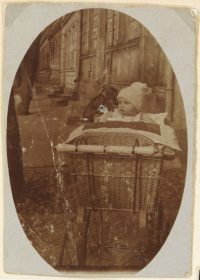
Walter Frankenstein in a baby carriage at the age of 7 ½ months, Flatow, February 1925; Jewish Museum Berlin, gift of Leonie and Walter Frankenstein
When I look at the picture of the infant in his baby carriage, it’s difficult for me to believe that it’s the same person who sat across from me just a few weeks ago in Stockholm at the age of nearly ninety-three years. It’s even harder for me to imagine the eventful life that lay between these two moments, which was shaped by a variety of sudden and in some cases tragic developments, as well as bold new starts.
I’m referring to the life of Walter Frankenstein, who donated more than 1,100 photographs to the Jewish Museum Berlin. Photos that depict his entire life from the earliest days of his childhood into old age. The picture of the baby carriage is the oldest photo among them. It shows Walter in February 1925 at the age of 7-1/2 months on a sidewalk in his hometown of Flatow (today known as Złotów), where he was born on June 30, 1924. His father, Max Frankenstein, owned a country shop and an inn there, which he had inherited from the parents of his first wife, Emma Frankenstein. After Emma died of sepsis in 1917, he married Walter’s mother, Martha Frankenstein née Fein.
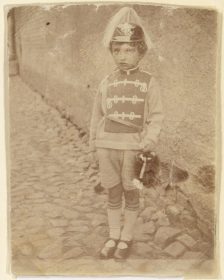
Walter Frankenstein dressed as a Prussian Hussar, Flatow, fall 1928; Jewish Museum Berlin, gift of Leonie and Walter Frankenstein
Although Walter Frankenstein stares somewhat sullenly into the lens in a photo from 1928, he spent the first happy years of his life in a loving environment. In the photo, Walter is dressed up as a Prussian Hussar. The costume was a gift from his uncle Selmar Frankenstein, who was an Oberstabsarzt (a medical staff officer on the level of a major or lieutenant commander) in the First World War in Hindenburg’s headquarters near Tannenberg, and also served as personal doctor to Crown Prince Rupprecht of Bavaria, for which he received several military decorations. He also wanted to instill his nephew with his patriotic, German nationalist outlook. Judging by the expression on Walter’s face, his measures met with only modest success.
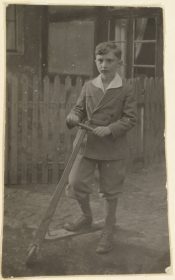
Walter Frankenstein with his new scooter, Flatow, Easter 1931; Jewish Museum Berlin, gift of Leonie and Walter Frankenstein
Walter Frankenstein was less for the military than for any and all types of transportation. He received a scooter for Easter in 1931, which only partially quenched his thirst for adventure. In order to increase his chances of going on a flight with a Junker, he “got engaged” that year to his Christian girlfriend Ingeborg Abraham, whose father was an airmail pilot.
But the flight never came to pass, because Ingeborg and her parents soon moved away. Beginning in 1933, his remaining Christian friends in Flatow began to pull away from Walter. In 1934, Walter’s brother Martin Frankenstein emigrated to Palestine—another early consequence of the National Socialists coming to power.
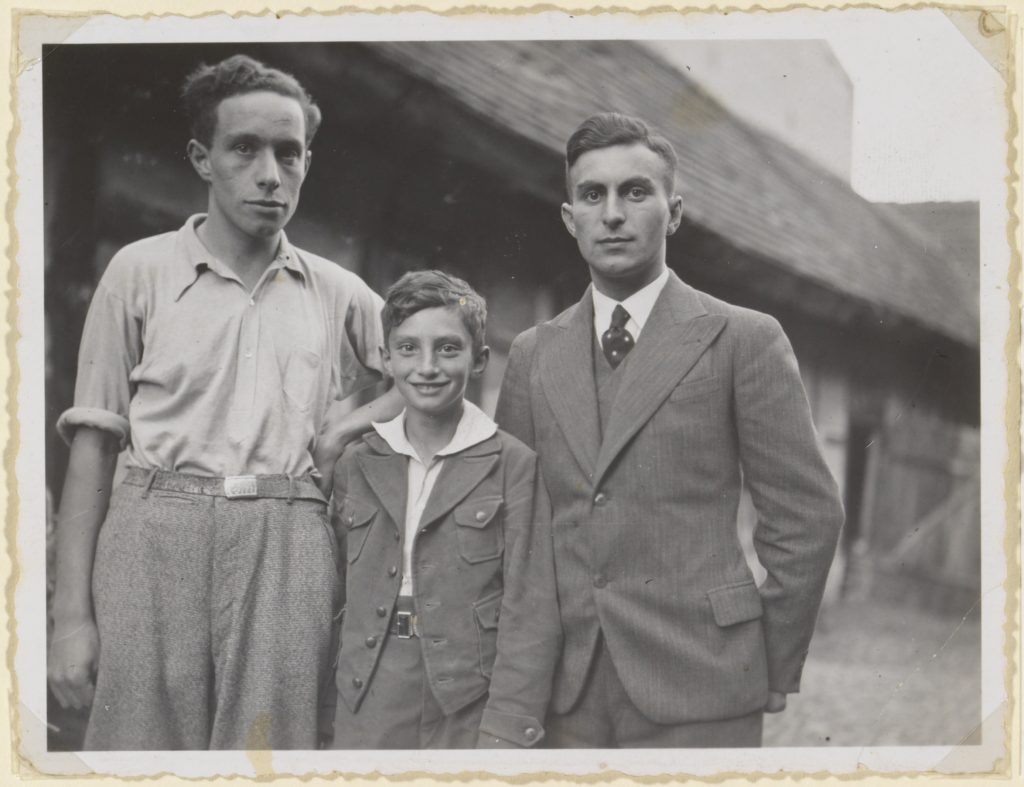
Martin Frankenstein with his brothers Manfred and Walter on the day before his emigration, Flatow, 1934; Jewish Museum Berlin, gift of Leonie and Walter Frankenstein
Martin had completed a business apprenticeship in the family’s clothing and ready-to-wear garment company in Bischofsburg, East Prussia (today: Biskupiec). After moving to Rishon leZion, Palestine, he worked as a mailman. The keepsake photo shot one day before his departure also shows Walter and Martin’s brother Manfred, who followed him to Palestine in 1937. Both Martin and Manfred were disinherited by their childless uncle Selmar. He viewed emigration to Palestine as betrayal of the fatherland.
Unlike his brothers, Walter remained in Germany, experiencing the increasing repressive measures taken by the National Socialist government against Jews. On April 1, 1933, when a boycott of Jewish businesses was declared, an unknown party shot at the windows of the Frankenstein’s shop, which Martha Frankenstein had run alone since her husband’s death in 1929.
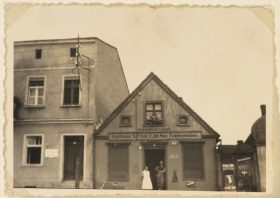
View of the Frankenstein family home in Flatow, Flatow, 1935; Jewish Museum Berlin, gift of Leonie and Walter Frankenstein
Walter told himself on that night: “Dear God, if this man doesn’t drop dead in the next fifty meters, then I won’t believe in you anymore.” He sums it up today: “He didn’t drop dead and I became an atheist. I still am, to this day.”
Despite this drastic experience, Walter’s mother continued to run the shop for a while. The last photo pictured here shows Walter and Martha Frankenstein standing in the doorway. The picture is also the last remaining shot of Walter in the town of his birth. Shortly thereafter, in summer 1936, twelve-year-old Walter was forbidden from attending the Christian school in Flatow. He had to move to the Auerbach Jewish Orphanage in Berlin, where the next chapter in his life begins.
Even after a year of intensive examination of Walter Frankenstein’s biography, Anna Rosemann remains captivated by it and is moved by his life accomplishments.
You can find more photographs from the life of the Frankenstein family in our online collection.
If you would like to learn more about Walter and Leonie Frankenstein’s life story, the book Nicht mit uns – Das Leben von Walter und Leonie Frankenstein (in German) by Klaus Hillenbrand is a good place to start. It was published in 2008 in Suhrkamp’s Jüdischer Verlag.